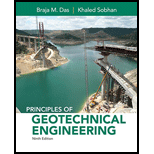
(a)
Calculate the dry unit weight of the soil.
(a)
Answer to Problem 3.4P
The dry unit weight of the soil is
Explanation of Solution
Given information:
The diameter of the cylindrical mold
The height of the cylindrical mold
The weight of the compacted soil
The moisture content
The specific gravity of the soil solids
Calculation:
Calculate the volume of the mold
Substitute
Calculate the dry unit weight of the soil
Substitute 4 lb for W,
Hence, the dry unit weight of the soil is
(b)
Calculate the void ratio of the soil.
(b)
Answer to Problem 3.4P
The void ratio of the soil is
Explanation of Solution
Given information:
The diameter of the cylindrical mold
The height of the cylindrical mold
The weight of the compacted soil
The moisture content
The specific gravity of the soil solids
Calculation:
Refer to part (a).
The dry unit weight of the soil
Consider the unit weight of water
Calculate the void ratio of the soil
Substitute 2.72 for
Hence, the void ratio of the soil is
(c)
Calculate the degree of saturation of the soil.
(c)
Answer to Problem 3.4P
The degree of saturation of the soil is
Explanation of Solution
Given information:
The diameter of the cylindrical mold
The height of the cylindrical mold
The weight of the compacted soil
The moisture content
The specific gravity of the soil solids
Calculation:
Refer to part (b).
The void ratio of the soil is 0.568.
Consider the unit weight of water
Calculate the degree of saturation
Substitute 2.72 for
Hence, the degree of saturation of the soil is
(d)
Calculate the additional water needed to achieve
(d)
Answer to Problem 3.4P
The required additional water to achieve
Explanation of Solution
Given information:
The diameter of the cylindrical mold
The height of the cylindrical mold
The weight of the compacted soil
The moisture content
The specific gravity of the soil solids
Calculation:
Refer to part (b).
The void ratio of the soil is 0.568.
Consider the unit weight of water
Calculate the saturated unit weight of the soil
Substitute 2.72 for
Calculate the unit weight
Substitute 4 lb for W and
Calculate the additional water needed to achieve
Substitute
Therefore, the additional water needed is
Want to see more full solutions like this?
Chapter 3 Solutions
Principles of Geotechnical Engineering (MindTap Course List)
- The following relates to Problems 4 and 5. Christchurch, New Zealand experienced a major earthquake on February 22, 2011. It destroyed 100,000 homes. Data were collected on a sample of 300 damaged homes. These data are saved in the file called CIEG315 Homework 4 data.xlsx, which is available on Canvas under Files. A subset of the data is shown in the accompanying table. Two of the variables are qualitative in nature: Wall construction and roof construction. Two of the variables are quantitative: (1) Peak ground acceleration (PGA), a measure of the intensity of ground shaking that the home experienced in the earthquake (in units of acceleration of gravity, g); (2) Damage, which indicates the amount of damage experienced in the earthquake in New Zealand dollars; and (3) Building value, the pre-earthquake value of the home in New Zealand dollars. PGA (g) Damage (NZ$) Building Value (NZ$) Wall Construction Roof Construction Property ID 1 0.645 2 0.101 141,416 2,826 253,000 B 305,000 B T 3…arrow_forwardfind SFD and BMDarrow_forwardThe data needed to answer this question is given by this link: https://docs.google.com/spreadsheets/d/1vzb03U7Uvzm7X-by3OchQNwYeREzbP6Z-xzZMP2tzNw/edit?usp=sharing if it is easier to make a copy of the data because it is on view only then feel free to do so.arrow_forward
- The data needed to answer this question is given in the following link (file is on view only so if you would like to make a copy to make it easier for yourself feel free to do so) https://docs.google.com/spreadsheets/d/1aV5rsxdNjHnkeTkm5VqHzBXZgW-Ptbs3vqwk0SYiQPo/edit?usp=sharingarrow_forwardA k 000 6 ft A kips Bl D ft C C kips 10 ft 12 ft E B k/ft D E ft tarrow_forwardH.W: show that the equations 1. (x+y)dy+(x-y)dx = 0 2. x²dy+(y²-xy)dx = 0 are homogeneous and solve:arrow_forward
- H.W: Solve the differential equation y' - (1+x)(1 + y²) = 0arrow_forwardThe benchmark is 00.00. The backsights are 6.00, 9.32 and 13.75 and 14.00 The foresights are 6.00, 9.00 and 3.22. What is the height of the instrument? H.I. - 100.00 - 124.85 - 43.07- 24.85arrow_forwardThe benchmark is 100.00. The backsights are 4.00, 6.32 and 12.75. The foresights are 6.00, 9.00 and 3.22. What is the elevation of the point? - 95.14 - 123.08 - 104.85 - 81.78arrow_forward
- Determine the stiffness matirx of the entire truss in Global co-ordinate system, clearly indicate the degrees of freedom numbers in the stiffness matrix.arrow_forwardDetermine the stiffness matrices of elements 2, 3 and 4 in the global co-ordinate system. Assume A=0.0015m2 and E=200GPa, indicate the degrees of freedom in all stiffness matricies.arrow_forwardA short plain concrete column with cross-section dimensions of 12 in x 12 in is to be constructed. If the compressive strength of the concrete (f’c) is 5000 psi, what is the maximum load that can be safely applied to the column? - 600 k - 950 k - 720 k - 347 karrow_forward
 Fundamentals of Geotechnical Engineering (MindTap...Civil EngineeringISBN:9781305635180Author:Braja M. Das, Nagaratnam SivakuganPublisher:Cengage Learning
Fundamentals of Geotechnical Engineering (MindTap...Civil EngineeringISBN:9781305635180Author:Braja M. Das, Nagaratnam SivakuganPublisher:Cengage Learning Principles of Geotechnical Engineering (MindTap C...Civil EngineeringISBN:9781305970939Author:Braja M. Das, Khaled SobhanPublisher:Cengage Learning
Principles of Geotechnical Engineering (MindTap C...Civil EngineeringISBN:9781305970939Author:Braja M. Das, Khaled SobhanPublisher:Cengage Learning Principles of Foundation Engineering (MindTap Cou...Civil EngineeringISBN:9781337705028Author:Braja M. Das, Nagaratnam SivakuganPublisher:Cengage Learning
Principles of Foundation Engineering (MindTap Cou...Civil EngineeringISBN:9781337705028Author:Braja M. Das, Nagaratnam SivakuganPublisher:Cengage Learning Principles of Foundation Engineering (MindTap Cou...Civil EngineeringISBN:9781305081550Author:Braja M. DasPublisher:Cengage Learning
Principles of Foundation Engineering (MindTap Cou...Civil EngineeringISBN:9781305081550Author:Braja M. DasPublisher:Cengage Learning



